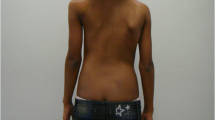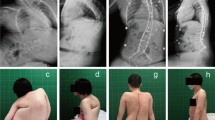Abstract
Purpose
To determine the prevalence of intraspinal alterations in scoliosis due to Spinal Muscular Atrophy (SMA).
Methods
Cross-sectional, observational, descriptive study. Fifty-six patients with SMA diagnosis required surgical treatment due to scoliosis. Inclusion criteria: scoliosis/kyphoscoliosis > 50 degrees in the coronal plane, clinical characteristics of Spinal Muscular Atrophy, accurate diagnosis by means of molecular or genetic study. Prior to the spinal surgery, and to find related intraspinal alterations, MRI of the spine and posterior cranial fossa was performed.
Results
Forty females, 16 males, mean age 11 years (range 6–14 years). 94% of the patients had Spinal Muscular Atrophy type 2. The mean angle value was 81 degrees (range 53–122 degrees) in the coronal plane and 62 degrees (range 35–80 degrees) in the sagittal plane. The prevalence of intraspinal alterations was 1.78%. One patient with cervical hydromyelia and no neurological surgical procedure prior to the spinal deformity surgery was reported.
Conclusions
In the context of preoperative planning and strategy of patients with scoliosis due to Spinal Muscular Atrophy, MRI may have not to be requested.
Similar content being viewed by others
Explore related subjects
Discover the latest articles, news and stories from top researchers in related subjects.Avoid common mistakes on your manuscript.
Introduction
Spinal muscular atrophy (SMA) is a genetic disorder of autosomal recessive inheritance in 95% of the cases. The disorder is characterized by the loss of motor neurons of the anterior horns of the spinal cord causing muscle atrophy leading to proximal muscle and trunk weakness. The estimated incidence is 1 in 11,000 live births. The natural history of SMA is complex, variable, and multifactorial. Based on the clinical features and age at diagnosis, the disease has been classified into different types and subtypes [1]. Type 0: hypotonic neonates with severe respiratory involvement and a life expectancy of less than 6 months; type 1 or Werdnig–Hoffman disease: infants younger than 6 months of life who cannot sit without support; type 2: children younger than 18 months who, although they are able to sit, cannot stand or walk independently; type 3 or Kugelberg–Welander disease: patients are generally older than 18 months and are able to walk without support at some point in their life; type 4: adult patients with the least severe form of the disease who walk independently [1, 2].
The incidence of scoliosis, one of the different orthopedic disorders associated with the disease, is between 50 and 70%. SMA-associated scoliosis is progressive in nature and the majority of patients need surgical treatment at some point during the course of the disease [3, 4].
Complementary studies are part of the evaluation and therapeutic strategy of the spinal deformity, and in this context, magnetic resonance imaging (MRI) is commonly used as the preoperative study of choice to rule out associated interspinal lesions [5, 6]
The aim of this study was to determine the prevalence of interspinal anomalies in SMA-associated neuromuscular scoliosis.
Materials and methods
An observational, cross-sectional, epidemiological study was conducted. Between 2005 and 2017, a total of 214 patients with SMA were evaluated; 56 required surgery because of the associated spinal deformity. Inclusion criteria were scoliosis/kyphoscoliosis > 50º in the coronal plane, clinical features of SMA, and a diagnosis confirmed by molecular genetic studies.
As part of the preoperative work-up, MRI of the whole spine and the posterior fossa was performed. A Toshiba Visart 1.5 T MRI equipment was used and T1- and T2-weighted and STIR images were acquired in the sagittal, coronal, and axial planes with a 5 mm slice thickness. In patients younger than 8 years and those who for some reason did not tolerate the procedure, the study was performed under general anesthesia.
The images were analyzed for associated intraspinal lesions, such as Chiari, syringomyelia, hydromyelia, tethered cord, tumors, and cysts, by at least one spine surgeon and an imaging specialist.
Results
Overall 56 patients, 40 women and 16 men, with a mean age of 11 years (range 6–14 years) at the time of surgery were evaluated.
Among the SMA subtypes, 53 patients had type 2, two had type 3, and only one patient had type 1. The most common spinal deformity and curve pattern was right thoracolumbar scoliosis, associated with pelvic obliquity in all cases. The mean angle value was 81º (range 52 º–124º) in the frontal and 62º (range 35º–93º) in the sagittal plane (Table 1).
Intraspinal lesions were detected on MRI in 1.78% of the patients with SMA-associated scoliosis (Fig. 1). No Chiari-type malformations, syringomyelia, tethered cord, tumors, or cysts were found. Only one patient with cervical hydromyelia was registered (Fig. 1), who did not undergo neurosurgery prior to the surgical correction of the spinal deformity.
Discussion
With the widespread use of the MRI, the detection of intraspinal lesions in patients with spinal deformities has become a topic of interest, not only for diagnostic purposes but also as part of the therapeutic strategy in patients who are scheduled to undergo surgery for the correction of their spinal deformity [7].
Based on routine MRI studies, Rajasekaran et al. showed that 35% of their patients with congenital scoliosis had some type of associated intraspinal anomaly [8]. Lee et al. reported intraspinal spinal lesions in 6.3% of 378 patients with adolescent idiopathic scoliosis detected previous to surgery, being syringomyelia and Chiari the most prevalent [9]. Swarup et al. analyzed MRI findings in 259 patients with adolescent idiopathic scoliosis excluding degenerative changes and extraspinal lesions. The authors found a rate of intraspinal disorders of 25%, of whom 1% needed neurosurgical treatment before undergoing surgery for the spinal deformity [10]. In a study of 56 patients with juvenile and adolescent idiopathic scoliosis, Maenza reported a rate of 19.6% of anomalies in the posterior cerebral fossa and the spinal cord canal [11].
In the evaluation of imaging studies, in particular MRI, in patients with SMA, Pradhan et al. identified morphological and dynamic changes in the cervical spinal cord in neutral and flexion position sequences [12]. Smith et al. described ventral spinal root atrophy in the lumbar region in a patient with SMA type 2 [13].
In our series, the prevalence of intraspinal anomalies was 1.78%. In the only case, a child with cervical hydromyelia, the lesion did not affect the surgical planning for the correction of the spine deformity. Hydromyelia is a congenital malformation of the spinal cord characterized by a non-contrast-enhancing dilation of a short segment of the central canal lined by ependymal cells. The lesion has a stable course and is neurologically asymptomatic. The lesion is also termed localized idiopathic hydromyelia to distinguish it from syringomyelia secondary to Chiari, trauma, infection, or tumor. Some authors define the entity as the presence of a persistent central canal [14, 15].
The routine use of MRI previous to the surgical correction of a spinal deformity is a controversial issue in the literature. Its potential benefits should be weighed against the risks, complications, and costs [7, 10]. As part of the surgical workup for correction of the spinal deformity, preoperative MRI is still a viable paradigm in, among others, congenital and idiopathic scoliosis.
In certain cases, such as younger patients and those who do not tolerate the study, MRI is performed under general anesthesia, which in these disorders may potentially increase the risk of complications. Considering our results and in addition to the above-mentioned aspects related to the study, owing to its high cost, the MRI places a significant financial burden on the health-care system. Therefore, the routine request for an MRI study previous to surgery for the correction of a spinal deformity should be evaluated. Last but not least, legal medical aspects should also be considered because of the risks and complications related to surgical treatment.
Conclusion
In the preoperative work-up or surgical planning in patients with SMA-associated neuromuscular scoliosis, MRI may not have to be requested.
References
Kolb S, Kissel J (2015) Spinal muscular atrophy. Neurol Clin 33(4):831–846
Zerres K, Schöneborn S, Forrest E et al (1997) A collaborative study on the natural history of childhood and juvenile onset proximal spinal muscular atrophy (type II and III SMA): 569 patients. J Neurol Sci 147:67–72
Rodillo E, Marini M, Heckmatt J et al (1989) Scoliosis in spinal muscular atrophy: review of 63 cases. J Child Neurol 4(2):118–123
Russman B, Melchreit R, Drennan J (1983) Spinal muscular atrophy: the natural course of disease. Muscle Nerve 6(3):179–181
Allam A, Schwabe A (2013) Neuromuscular scoliosis. PMR 5(11):957–963
Berven S, Bradford D (2002) Neuromuscular scoliosis: causes of deformity and principles for evaluation and management. Semin Neurol 22(2):167–168
Dewan V, Gardner A, Forster S et al (2018) Is the routine use of magnetic resonance imaging indicated in patients with scoliosis? J Spine Surg 4(3):575–582
Rajasekaran S, Kamath V, Kiran R et al (2010) Intraspinal anomalies in scoliosis: an MRI analysis of 177 consecutive scoliosis patients. Indian J Orthop 44(1):57–63
Lee C, Hwang C, Kim N et al (2017) Preoperative magnetic resonance imaging evaluation in patients with adolescent idiopathic scoliosis. Asian Spine J 11(1):37–43
Swarup I, Silberman J, Blanco J et al (2019) Incidence of intraspinal and extraspinal mri abnormalities in patients with adolescent idiopathic scoliosis. Spine Deform 7(1):47–52
Maenza R (2003) Juvenile and adolescent idiopathic scoliosis: magnetic resonance imaging evaluation and clinical indications. J Pediatr Orthop B 12(5):295–302
Pradha S, Gupta R (1997) Magnetic resonance imaging in juvenile segmental spinal muscular atrophy. J Neurol Sci 146(2):133–138
Smith G, Bell S, Sladky J et al (2019) Lumbosacral ventral spinal nerve root atrophy identified on MRI in a case of spinal muscular atrophy type II. Clin Imaging 53:134–137
Roser F, Ebner F, Sixt C et al (2010) Defining the line between hydromyelia and syringomyelia. A differentiation is possible based on electrophysiological and magnetic resonance imaging studies. Acta Neurochir 152(2):213–219
Jinkins J, Sener R (1999) Idiopathic localized hydromyelia: dilatation of the central canal of the spinal cord of probable congenital origin. J Comput Assist Tomogr 23(3):351–353
Funding
Not applicable.
Author information
Authors and Affiliations
Corresponding author
Ethics declarations
Conflict of interest
The authors declare that they have not competing interest. No conflict of interest or funding received during the conduct of this study.
Ethical approval and informed consent
The study was approved by the hospital Institutional Review Board (IRB), because of the retrospective observational nature of the study IRB waived the informed consent.
Additional information
Publisher's Note
Springer Nature remains neutral with regard to jurisdictional claims in published maps and institutional affiliations.
Rights and permissions
About this article
Cite this article
Davies, N.R., Galaretto, E., Piantoni, L. et al. Scoliosis in spinal muscular atrophy: is the preoperative magnetic resonance imaging necessary?. Spine Deform 8, 1089–1091 (2020). https://doi.org/10.1007/s43390-020-00134-0
Received:
Accepted:
Published:
Issue Date:
DOI: https://doi.org/10.1007/s43390-020-00134-0





